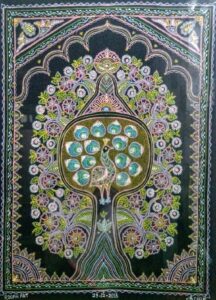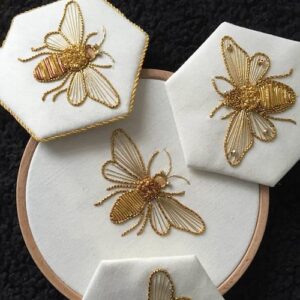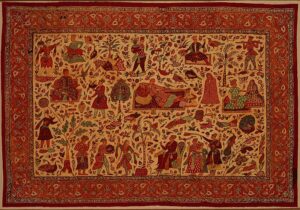Everything you need to know about the weaving of
Bihar’s Sujini Embroidery.
What is Bihar's Sujini Embroidery?
Sujini is also written as Sujani.
It is derived from ‘Su’ and ‘Jani’.
Su means simple and smooth while Jani means birth.
Sujini embroidery is an impressive textile art item.
It was also known as quilting earlier.
It is generally performed on a bed or quilt cover.
This was created with the old cloths before but now they use cloth on which the embroidery has already been done.
Sujini embroidery is only created by women belonging to 15 suburbs of Bhusra in Gaighat block, Muzaffarpur.
How did it begin?
It is a traditional practice of creating Sujini embroidery quilt tracked to the eighteenth century.
The intention is to provide a soft spread to the newly born.
The needleworker used various fabric pieces obtained from already worn saris and dhotis by stitching them together.
These were used as creative canvases to provide a clear stitch and gave a hint of newness.
The Process
The raw material is essential for Sujini embroidery.
The process starts with drawing the designs on the base fabric.
Then needleworkers start modelling the background by fine running stitch.
Black or brown threads are utilised for preparing the themes while the colourful threads are utilised to fill colours in the themes.
Sujani Kantha stitch comprises a needle, fabric, shears, threads of different colours, measuring tape, tracing sheet, tracing wheel, pencil, eraser, blue chalk and kerosene.
What are the motifs used?
Motifs are stitched as per the choices of women and show the need of a mother for her newly born.
This is with the help of stitching done using dark indicating forces of life, for example, red and yellow colour.
While the red colour denotes blood, yellow symbolises the Sun.
The motifs stitched on the quilt show sun and a cloud.
This represents life-giving forces, fertility sign, sacred and mythical creatures to give protection from the evils.
This showers the blessings of the Gods.
The pattern declined but was restored in 1988 when the Mahila Vikas Sahyog Samiti (MVSS) was introduced by Nirmal Devi.
This was an autonomous society based in Bhusra village which is now near to Muzaffarpur.
In the present time, 600 women belonging to Bhusra village practice this craft.
Are there any beliefs attached?
The Sujini procedure depends on two old convictions.
In one formal custom, it spoke to the nearness of a divinity known as “Chitiriya Ma, the Lady of the Tatters”.
It represented the idea of bringing together disjointed components comprehensively into a brought together entirety.
The subsequent target was to make a delicate blanket to wrap the newly born as though the kid was in the delicate embrace of its mom.
Product specifications.
The products manufactured by the village women include quilt as well as bed covers featuring rural scenarios, Hindu epics, existing social themes, for example, violence at the time of voting, female infanticide, women literacy and household violence.
Beyond this, health aspects regarding the surroundings and the right of the women are also depicted.
The embroidery done on the quilt represents agony and the aspirations of women in the male-dominated world.
They prepare the work by performing embroidery on both sides while stitching particular motifs.
While one side depicts brutal drunk men for their wives, providing a dowry to the family at the time of the wedding, village men collected for a meeting, women wrapped with a curtain, another side shows aspirations of women to be independent by selling items in the market, lectured provided by women in assembly, women carrying court and representing her abilities.
The material used is cheap as well as costly.
The cotton material which is named as Salita is costly. While the marking in white or in different shades, Tussar silk, casement fabric and threads used for weaving are cheap.
The embroidery stitch is the same as the background fabric.
The pattern is highlighted by chain stitching using the thread of the colour black, brown as well as red.
How is it different from Kantha stitch?
Sujani embroidery resembles Kantha stitch of West Bengal but varies from one another in terms of hues, motifs and motifs.
The main difference is that in Kantha weaving craftsmen do not follow a particular method of stitching as they follow any direction of their choice while Sunjini embroidery deals with stitching carried out in straight lines.
Sujini is mainly on cream-coloured cloth with motifs stitched using black thread and various hues thread to fill colours.
The uses
The needleworker utilizes fine running stitch to prepare attractive motifs such as Gods, blossoms as well as peacock patterns door decorating the walls.
Some of the famous items for decorating homes comprises cushion spreads, bed covers as well as wall hangings.
Not restricted to this as time passed, the needleworker initiated Sujini embellished Indian outfits such as sarees, kurtas, dupattas and various other cloth items.
Products for the winter season include Sujani embroidered stoles as well as jackets with Tussar silk fabric.
What are the sources of inspiration?
Sujini embroidery comprises layered bits of discarded fabric stitched together.
It is a traditional practice as the discarded cloth was assumed to be appropriate for newly born and serves the objective of a spread or quilt.
Plus, another ceremonial should conjure a goddess named ‘Chitiriya Maa,’ who was hailed as the ‘Woman of the Tatters’.
From sun and cloud themes, which represented powers of life, to different examples like that of holy creatures and fruitful images which should bring out gifts from divine beings.
Indeed, even hues had topical criticalness, with red representing essentialness and yellow representing the sun.
Are there any advancements?
Sujini started as a traditional craft as it also informs about the social and political news.
Sujini quilt reveals physical violence by a drunken man on his wife, women forced to notice the purdah, dowry practice at the time of the wedding, women speaking in front of the crowd, a female judge as well as women selling items for livelihood.
What is the status in today’s time?
As other crafts of Bihar tend to popularize such as Madhubani as well as papier-mache, it led to the decline of Sujini embroidery.
Though Sujini embroidery is awarded UNESCO Seal of Excellence 2019.
It is known as the Seal Award. Sujini painting is at the phase of vagueness.
Presently, they are created in 15 Indian villages.
The women belonging to Muzaffarpur region carry on embroidery in the Sujani style utilizing various fine running stitches as well as chain stitch.
Sujini embroidery is the main source of income as they are prohibited to go out for work.
Sujini embroidery was awarded.
Is Sujani embroidery protected?
On 21 September 2006, the Sujini weaving was secured under the Geographical Indications tag.
It was provided under the category “Sujini Embroidery Work of Bihar” by the Controller General of Patents Designs and Trademarks.
Did we miss something?
Let us know in the comments down below!











